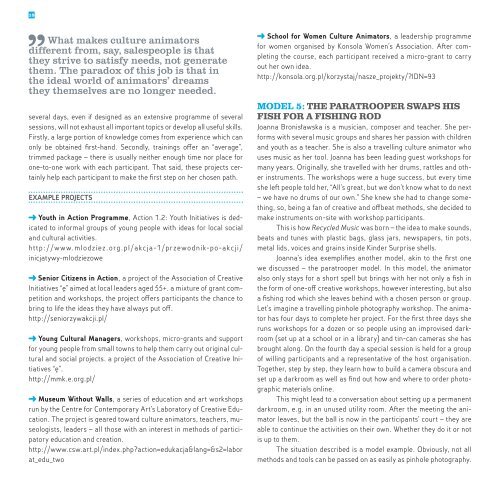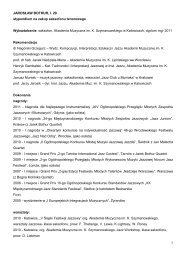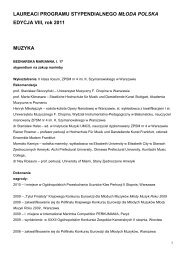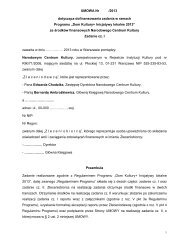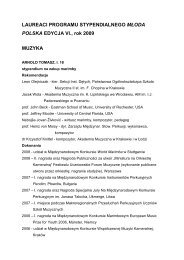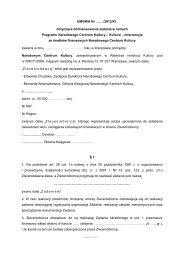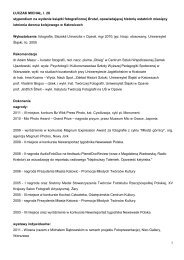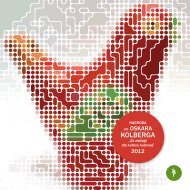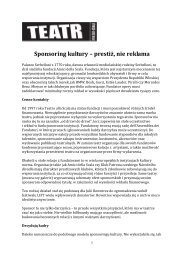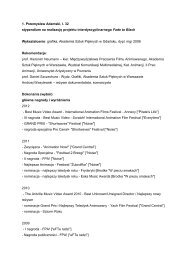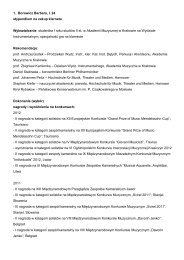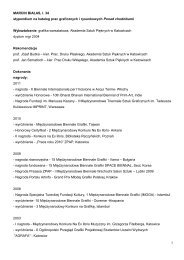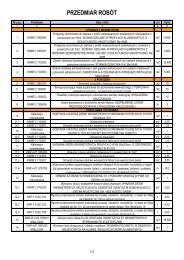Untitled - Narodowe Centrum Kultury
Untitled - Narodowe Centrum Kultury
Untitled - Narodowe Centrum Kultury
Create successful ePaper yourself
Turn your PDF publications into a flip-book with our unique Google optimized e-Paper software.
18<br />
What makes culture animators<br />
different from, say, salespeople is that<br />
they strive to satisfy needs, not generate<br />
them. The paradox of this job is that in<br />
the ideal world of animators’ dreams<br />
they themselves are no longer needed.<br />
several days, even if designed as an extensive programme of several<br />
sessions, will not exhaust all important topics or develop all useful skills.<br />
Firstly, a large portion of knowledge comes from experience which can<br />
only be obtained first-hand. Secondly, trainings offer an “average”,<br />
trimmed package – there is usually neither enough time nor place for<br />
one-to-one work with each participant. That said, these projects certainly<br />
help each participant to make the first step on her chosen path.<br />
Example projects<br />
Youth in Action Programme, Action 1.2: Youth Initiatives is dedicated<br />
to informal groups of young people with ideas for local social<br />
and cultural activities.<br />
http://www.mlodziez.org.pl/akcja-1/przewodnik-po-akcji/<br />
inicjatywy-mlodziezowe<br />
Senior Citizens in Action, a project of the Association of Creative<br />
Initiatives “ę” aimed at local leaders aged 55+. a mixture of grant competition<br />
and workshops, the project offers participants the chance to<br />
bring to life the ideas they have always put off.<br />
http://seniorzywakcji.pl/<br />
Young Cultural Managers, workshops, micro-grants and support<br />
for young people from small towns to help them carry out original cultural<br />
and social projects. a project of the Association of Creative Initiatives<br />
“ę”.<br />
http://mmk.e.org.pl/<br />
Museum Without Walls, a series of education and art workshops<br />
run by the Centre for Contemporary Art’s Laboratory of Creative Education.<br />
The project is geared toward culture animators, teachers, museologists,<br />
leaders – all those with an interest in methods of participatory<br />
education and creation.<br />
http://www.csw.art.pl/index.phpaction=edukacja&lang=&s2=labor<br />
at_edu_two<br />
School for Women Culture Animators, a leadership programme<br />
for women organised by Konsola Women’s Association. After completing<br />
the course, each participant received a micro-grant to carry<br />
out her own idea.<br />
http://konsola.org.pl/korzystaj/nasze_projekty/IDN=93<br />
Model 5: The paratrooper swaps his<br />
fish for a fishing rod<br />
Joanna Bronisławska is a musician, composer and teacher. She performs<br />
with several music groups and shares her passion with children<br />
and youth as a teacher. She is also a travelling culture animator who<br />
uses music as her tool. Joanna has been leading guest workshops for<br />
many years. Originally, she travelled with her drums, rattles and other<br />
instruments. The workshops were a huge success, but every time<br />
she left people told her, “All’s great, but we don’t know what to do next<br />
– we have no drums of our own.” She knew she had to change something,<br />
so, being a fan of creative and offbeat methods, she decided to<br />
make instruments on-site with workshop participants.<br />
This is how Recycled Music was born – the idea to make sounds,<br />
beats and tunes with plastic bags, glass jars, newspapers, tin pots,<br />
metal lids, voices and grains inside Kinder Surprise shells.<br />
Joanna’s idea exemplifies another model, akin to the first one<br />
we discussed – the paratrooper model. In this model, the animator<br />
also only stays for a short spell but brings with her not only a fish in<br />
the form of one-off creative workshops, however interesting, but also<br />
a fishing rod which she leaves behind with a chosen person or group.<br />
Let’s imagine a travelling pinhole photography workshop. The animator<br />
has four days to complete her project. For the first three days she<br />
runs workshops for a dozen or so people using an improvised darkroom<br />
(set up at a school or in a library) and tin-can cameras she has<br />
brought along. On the fourth day a special session is held for a group<br />
of willing participants and a representative of the host organisation.<br />
Together, step by step, they learn how to build a camera obscura and<br />
set up a darkroom as well as find out how and where to order photographic<br />
materials online.<br />
This might lead to a conversation about setting up a permanent<br />
darkroom, e.g. in an unused utility room. After the meeting the animator<br />
leaves, but the ball is now in the participants’ court – they are<br />
able to continue the activities on their own. Whether they do it or not<br />
is up to them.<br />
The situation described is a model example. Obviously, not all<br />
methods and tools can be passed on as easily as pinhole photography.


